Identity Management Blockchain: The Complete 2025 Guide
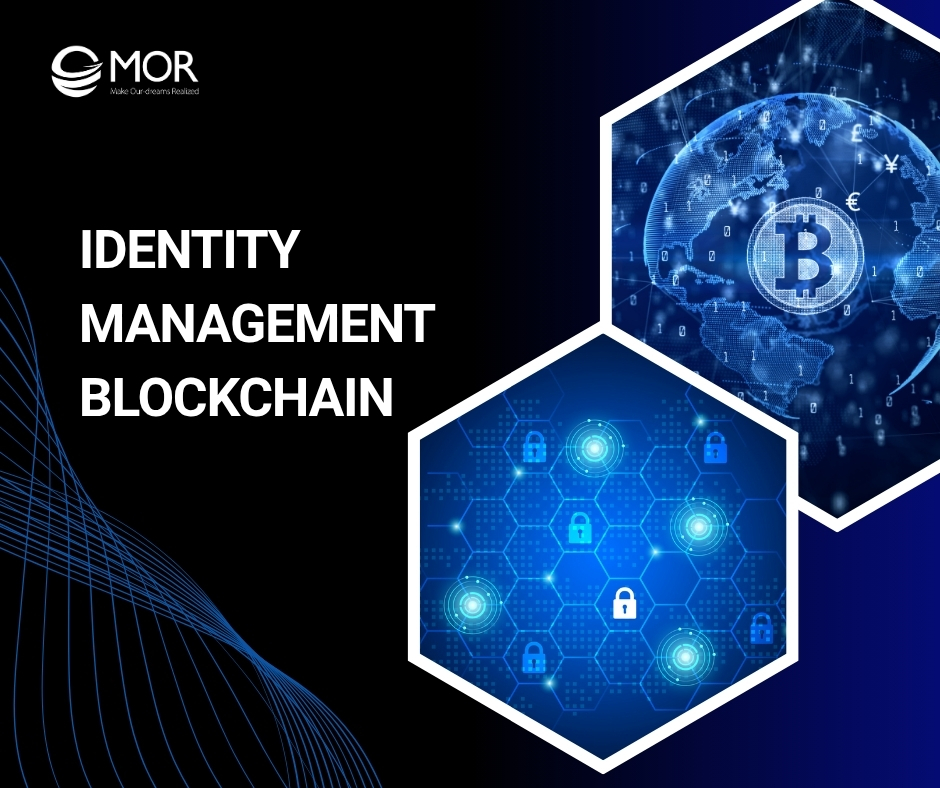
Traditional identity systems are crumbling under rising data breaches, privacy concerns, and growing user frustration. Identity management blockchain is changing that, offering a safer, faster, and user-controlled way to prove who we are online. In this MOR Software’s guide, we explore how blockchain transforms digital identity and powers the future of authentication.
What Is Digital Identity Management?
Digital identity management refers to the processes, technologies, and policies that control how users access systems, applications, and data across digital environments. It verifies user identities, authenticates access, and ensures that only authorized individuals can reach specific resources. As businesses expand their online operations, managing identities securely and efficiently has become a foundation for data protection and trust.
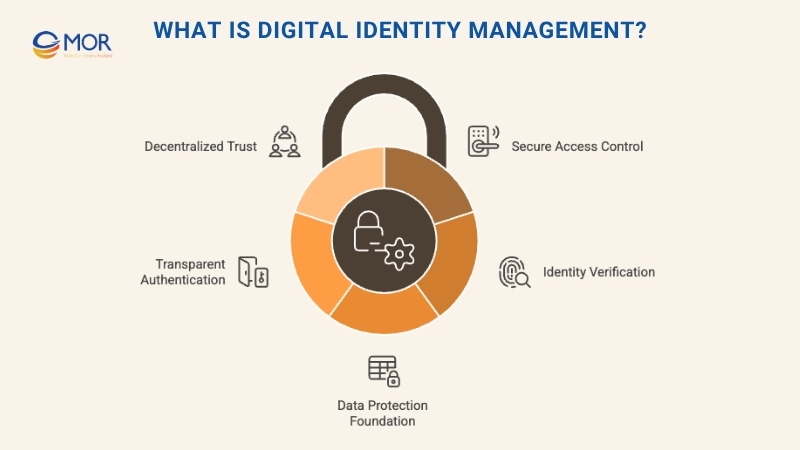
Traditional systems are now being replaced with more advanced solutions like identity management blockchain, which brings transparency and decentralization to digital verification. This approach not only strengthens security but also simplifies access across blockchain platforms without relying on a single authority.
Common Problems In Traditional Identity Management Systems
A digital identity represents all data that defines a person or organization online. It includes details like login credentials, purchase records, identification numbers, and browsing patterns. Today, most digital identities are linked across multiple apps, devices, and services through centralized or federated identity models that rely on a single control point.
As companies gather and store large volumes of personal data, they face growing exposure to regulatory and privacy risks. Global laws such as the General Data Protection Regulation (GDPR) and the California Consumer Privacy Act (CCPA) hold organizations accountable for protecting user information. These regulations apply even to businesses operating outside their regions, pushing enterprises to look for new, secure solutions like identity management blockchain to maintain compliance and build user trust.
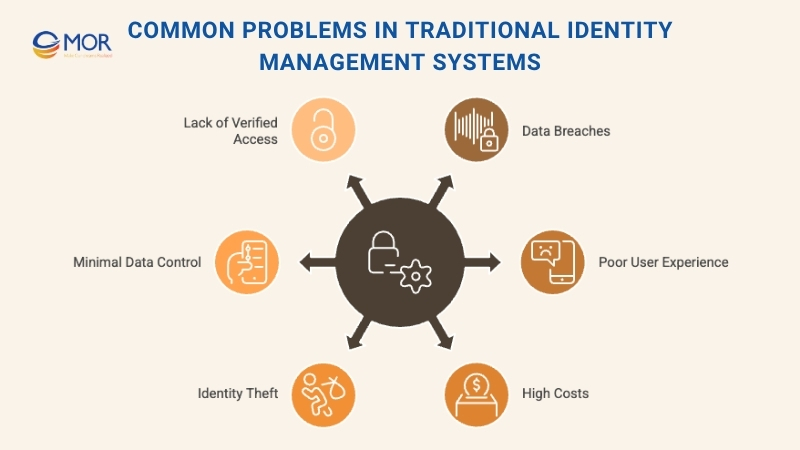
Data Breaches In Centralized And Federated Systems
Centralized identity systems store user credentials and profile information under a single authority, while federated systems let users access multiple platforms with one login, such as using Google or Facebook to sign in. This model, often known as single sign-on (SSO), improves convenience but increases exposure to cyberattacks.
The main issue is concentration. When all personal information is stored in one location, it becomes a prime target for hackers. A single breach can expose millions of records at once, leading to widespread identity theft. Reports show that personally identifiable information (PII) makes up nearly 97% of all data breaches, highlighting how easily centralized storage can compromise privacy. Even in federated setups, if one password is compromised, every connected service becomes vulnerable, making users’ entire digital footprint open to attack.
Emerging smart contract platforms like identity management blockchain aim to solve this by decentralizing data ownership and eliminating single points of failure.
Poor User Experience With Multiple Accounts
Centralized identity systems force users to create new accounts and passwords every time they register for a new service or platform. This leads to more personal data stored online and more credentials to manage. On average, a single user handles around 100 passwords, which increases both fatigue and risk. Every additional login adds another point of exposure, making digital identity management unnecessarily complex and insecure.
High Cost And Complexity Of KYC/AML Procedures
Traditional identity verification methods, including Know Your Customer (KYC) and Anti-Money Laundering (AML) checks, remain costly and slow. These processes involve coordination between users, organizations, and multiple third parties to validate documents and confirm legitimacy. Global spending on AML/KYC data and services surpassed $1.6 billion in 2022, showing the heavy financial burden of compliance.
Manual reviews, document uploads, and repeated verification steps slow operations and consume resources. For industries like banking, healthcare, and immigration, these inefficiencies highlight why businesses are exploring identity management blockchain to automate verification, lower costs, and maintain compliance without sacrificing security.
Rising Identity Theft Cases
Identity theft continues to cause massive financial losses each year, with global damages reaching billions of dollars. Beyond the monetary impact, the growing scale of digital transactions and data sharing has made personal information easier to steal and misuse.
One alarming trend is the rise of child identity fraud. In 2020, more than one million children were victims of identity theft, often linked to stolen Social Security numbers and unauthorized credit use. Government benefits fraud also led reported cases in 2021, followed closely by credit card scams.
Equally concerning, around 87% of internet users have unknowingly exposed personal information while accessing online banking or email accounts. These risks demonstrate why organizations are adopting identity management blockchain to give users greater control over personal data, reduce identity theft incidents, and strengthen trust in digital interactions.
Minimal Control Over Personal Data
In traditional centralized and federated identity systems, users rarely control how their personal information is collected, stored, or shared. Once data is submitted, it’s managed by third-party providers who can use or distribute it without direct consent. Most individuals have no visibility into where their personally identifiable information (PII) resides or whether it has been accessed by unauthorized parties. This lack of ownership undermines transparency and exposes users to privacy violations.
Lack Of Verified Identity Access
Roughly one billion people still lack official proof of identity, and nearly 1.7 billion adults remain unbanked globally. Without recognized identification, many individuals are excluded from essential services like education, employment, healthcare, and financial support. Identity management blockchain provides a potential solution by enabling digital credentials that are verifiable, portable, and independent of government or corporate control. It helps bridge the gap for the unregistered population while building a trusted foundation for inclusion in the global economy.
>>> As businesses look for smarter and more secure digital systems, enterprise blockchain solutions are emerging as a trusted foundation for transparency and efficiency. So how enterprise blockchain drives real business value and what it takes to build scalable, future-ready solutions? Let's explore!
How Identity Management Blockchain Transforms Digital Verification
Identity management blockchain introduces a new way to verify and protect digital identities through cryptographic security and decentralization. Instead of relying on third parties to validate credentials, blockchain identity systems allow users to store and manage their own verified data in encrypted digital wallets. This setup removes unnecessary intermediaries and significantly reduces the risk of identity theft or fraud.
Information shared through blockchain identity management is auditable and verifiable in seconds, providing transparency without sacrificing privacy. Each transaction or credential update is permanently recorded on a distributed ledger, ensuring data accuracy and authenticity.
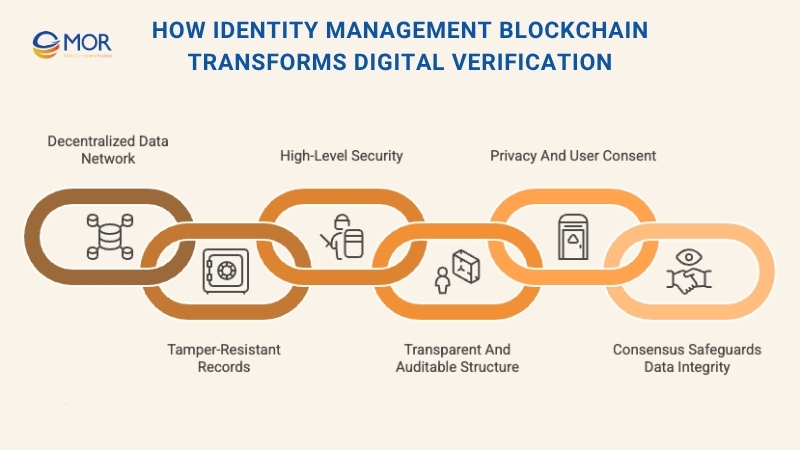
What Makes Blockchain Different
A blockchain is a shared digital ledger replicated across multiple computers, known as nodes. Every transaction added to the ledger is timestamped, verified, and linked to previous records, forming a secure chain of data blocks. Once entered, this information can’t be altered without modifying every subsequent block across the network, making tampering nearly impossible.
For digital identity verification, this means each credential can be validated instantly across a trusted network. Users retain control, and verifiers can confirm authenticity without accessing raw personal data, an approach that modernizes blockchain digital identity solutions and reshapes how trust is established online.
Core Strengths Of Identity Management Blockchain
The true value of blockchain in digital identity lies in its foundational strengths. These core features make identity management blockchain systems more secure, transparent, and resilient than any traditional model.
Decentralized Data Network
In a blockchain identity management system, data is stored across a distributed ledger instead of one central authority. Every participant in the network holds a synchronized copy of the ledger, which ensures transparency and eliminates manipulation. Before any transaction or update is added, the majority of network nodes must confirm its validity. This consensus mechanisms prevent unauthorized changes and removes the single point of failure found in traditional systems. The result is a blockchain digital identity structure that is both open and secure.
Tamper-Resistant Records
Once verified and recorded, blockchain data cannot be altered, deleted, or backdated. Each transaction is encrypted and linked to previous blocks, forming a permanent and auditable record. This immutability guarantees data integrity, helping organizations and users trust the authenticity of every verified credential. Creating a secure, transparent, and traceable environment, identity management blockchain builds confidence among all stakeholders and reduces the risk of fraud or data manipulation.
High-Level Security
Every transaction within an identity management blockchain network is protected through advanced cryptography. Instead of storing personal information directly on the chain, only encrypted references, such as an issuer’s public blockchain key, are recorded. This design ensures that personally identifiable information remains private while still allowing verifiers to confirm whether a credential is legitimate. It’s a model that strengthens trust and minimizes the risk of data exposure or unauthorized access.
Transparent And Auditable Structure
All transactions on the blockchain are traceable and verifiable by participants in the network. Each record leaves a permanent audit trail that confirms the validity of the data without allowing any modifications. This transparency helps organizations meet compliance requirements while building accountability into every identity-related action.
Privacy And User Consent
Privacy laws worldwide now demand user control over personal data. With identity on blockchain, individuals store their information in secure digital wallets and decide when, how, and with whom to share it. Verification can happen without exposing unnecessary details. For instance, a user can prove they’re over 19 without disclosing their full birth date, showcasing how self-sovereign identity blockchain solutions enable privacy-preserving verification for modern digital systems.
Consensus Safeguards Data Integrity
Within an identity management blockchain, consensus mechanisms act as a built-in verification system that prevents fraudulent or inaccurate information from entering the ledger. Each network participant, or node, must agree on the validity of a transaction before it’s added. This collective validation process ensures that every identity record stored is accurate, trusted, and tamper-proof.
Through removing reliance on a single authority, blockchain and identity management systems maintain the authenticity of identity data across the entire network, reinforcing transparency and trust between all users.
Decentralized Identifiers Vs Verifiable Credentials In Identity Management Blockchain
To understand how blockchain strengthens digital identity, it helps to look at its two core components: decentralized identifiers and verifiable credentials. Together, they redefine how users prove and protect who they are online.
Decentralized Identifiers (DIDs)
Most people today still rely on traditional credentials like emails, usernames, and passwords to prove who they are online. Yet, these identifiers come with major drawbacks. Blockchain testing service providers can revoke access at any time, personal data linked to those accounts can be shared without consent, and centralized storage exposes users to breaches and surveillance. In short, users don’t truly own their digital identities.
Decentralized identifiers (DIDs) solve these problems by giving users full control of their credentials through blockchain-based authentication. A DID is a unique, cryptographically generated identifier, made up of random letters and numbers, stored securely in a user’s digital wallet. Unlike conventional logins, it isn’t tied to a single platform or company. DIDs can represent individuals, organizations, or even devices, enabling a self-managed identity that is portable and secure across networks.
For instance, a sample DID might look like this:
did:dock:5GL3xbkr3vfs4qJ94YUHwpVVsPSSAyvJcafHz1wNb5zrSPGi
This approach marks a major shift in identity management and blockchain, empowering users to own their digital presence without depending on centralized authorities.
Benefits Of Decentralized Identifiers
Decentralized identifiers give both individuals and organizations complete control over their digital presence. Each DID is owned and managed solely by the user, meaning no external party can revoke or alter it. The owner can also prove cryptographic control, ensuring that every interaction tied to their identity is authentic and verifiable.
Because DIDs don’t store personal or wallet information directly on the chain, they protect user privacy while allowing secure, encrypted connections between two parties. These identifiers can be verified instantly from anywhere, making them ideal for global digital transactions and authentication.
Users can create multiple DIDs for different purposes, keeping activities separated for added privacy:
- DID 1: Gaming accounts
- DID 2: Online banking
- DID 3: National ID or work credentials
- DID 4: Online shopping
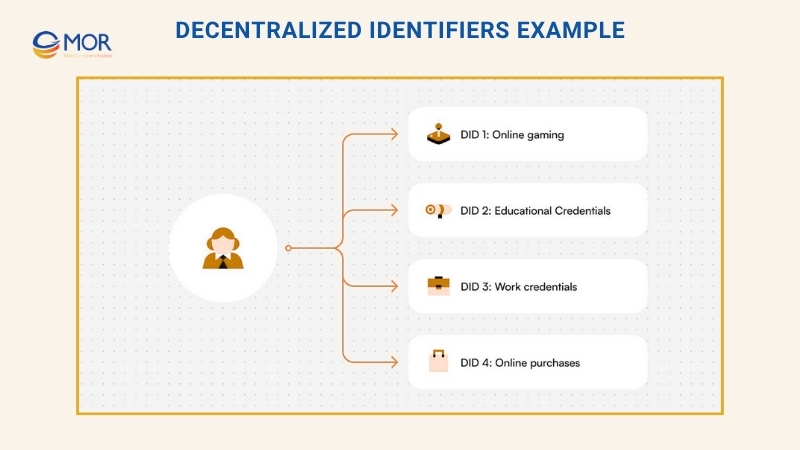
This flexibility reflects how digital identity blockchain projects are reshaping identity ownership and user autonomy in the online world.
Verifiable Credentials (VCs)
Verifiable Credentials (VCs) are digital, cryptographically protected versions of traditional documents such as passports, national IDs, or driver’s licenses. Instead of presenting physical papers or uploading scans, users can share a secure digital credential that verifies authenticity instantly.
Each decentralized identifier (DID) can have several VCs linked to it, all issued and signed by trusted entities like government agencies or educational institutions. These digital signatures confirm legitimacy without exposing unnecessary personal data. The user, not the issuing authority, stores these credentials in their mobile identity wallet, maintaining full control over access and usage.
With identity on blockchain, verification happens directly between the user and the verifier, removing intermediaries like Google or Facebook. This model enables fast, secure, and privacy-preserving authentication that fits the principles of blockchain identity verification and supports self-sovereign digital identity.
Here’s how blockchain identity management operates:
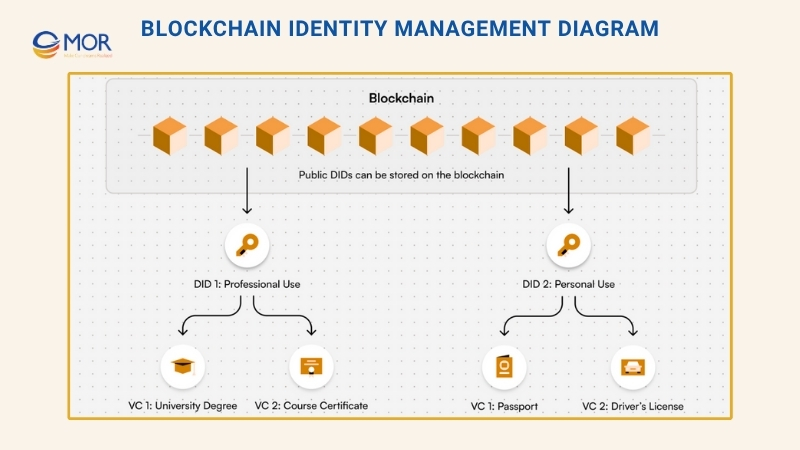
Organizational Benefits Of Identity Management Blockchain Solutions
Blockchain identity systems don’t just improve security, they also transform how organizations verify, manage, and protect user data. The following benefits show why more enterprises are shifting toward decentralized identity models.
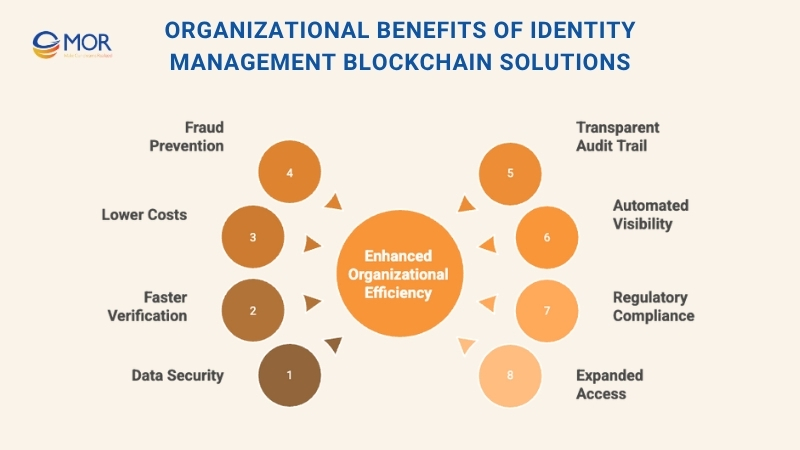
Data Security
Traditional systems store sensitive information in centralized databases, making them prime targets for hackers. With identity management blockchain, users store and control their own data through encrypted digital smart contract wallets. This decentralized structure drastically reduces the risk of large-scale breaches since there’s no single repository to exploit.
Faster Verification And Authentication
Verifying identity through blockchain is nearly instantaneous. Cryptography ensures that all credentials are genuine, allowing verifiers to confirm authenticity directly on the network without contacting the issuer. This accelerates onboarding, transaction approvals, and compliance checks.
Lower Operational Costs
Legacy system often depends on manual reviews, multiple tools, and large teams. Blockchain eliminates most of this overhead. Once a credential is issued, it can be verified automatically, cutting down both time and cost for organizations.
Fraud Prevention
Blockchain identity management helps prevent identity fraud through cryptographic proof of ownership. Each digital identifier (DID) is mathematically linked to its rightful owner, making it impossible for impersonators to falsify or reuse credentials.
Transparent Audit Trail
Every Verifiable Credential on the blockchain is digitally signed by its issuer and stored immutably. This creates a permanent audit trail that promotes data accountability and prevents unauthorized tampering, whether from internal or external actors.
Automated Data Visibility
Blockchain security maintains a synchronized ledger shared across participants, ensuring all verified data is automatically updated and accessible to authorized stakeholders. It serves as a trusted, unified source of truth without manual reconciliation.
Regulatory Compliance
With privacy laws like GDPR and CCPA tightening worldwide, blockchain digital identity systems simplify compliance. Users control how and when their data is shared, and consent mechanisms are embedded within the system’s architecture.
Expanded Access To Identity
Roughly a billion people lack formal identification, limiting access to education, jobs, and financial services. Through mobile-based blockchain identity wallets, even individuals in remote or underserved areas can hold verifiable credentials, improving inclusion and opportunity.
User Benefits Of Blockchain Identity Management
For everyday users, blockchain identity brings convenience, privacy, and control that traditional systems can’t match. It simplifies verification while giving individuals complete ownership of their digital identities.
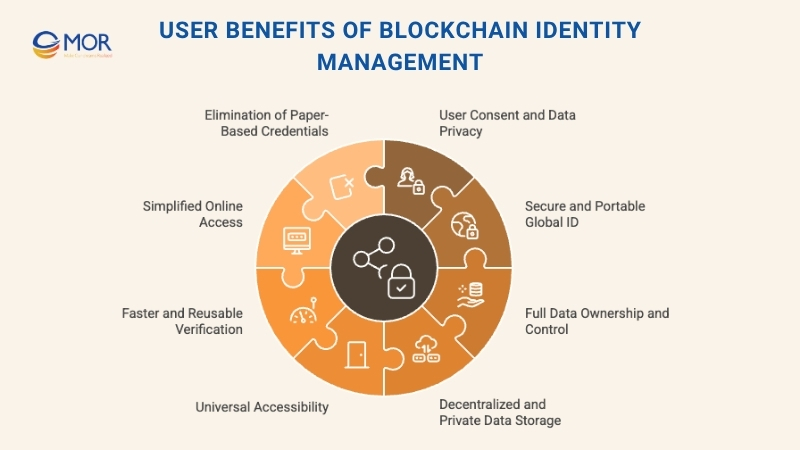
User Consent And Data Privacy
A core benefit of identity management blockchain systems is that users decide exactly what data to share and with whom. No personal information can be accessed without explicit consent. When a verifier requests proof, the user receives a prompt to approve or deny the request. They can also choose to disclose only partial details, for instance, confirming the city they live in without sharing their full address.
This data minimization approach, combined with technologies like Zero-Knowledge Proofs, allows users to prove facts without revealing the underlying data. A person can verify they’re over 18 to buy alcohol without exposing their actual birth date, demonstrating how blockchain identity verification enhances privacy while keeping interactions seamless.
Secure And Portable Global ID
Each blockchain ID is encrypted and securely stored within the user’s mobile device, ensuring that sensitive data remains under personal control. The DID can be used across borders to authenticate identity instantly, without relying on third-party intermediaries. This creates a portable, trusted global identity that simplifies online transactions, travel verification, and access to digital services anywhere in the world.
Full Data Ownership And Control
With identity management blockchain, individuals maintain complete ownership of their digital identities. No authority or service provider can revoke access or alter their decentralized identifier (DID) without permission. Every data-sharing action requires explicit user consent, reinforcing autonomy and trust in digital interactions.
Decentralized And Private Data Storage
Unlike centralized databases that store millions of user records in one place, identity on the blockchain relies on decentralized storage. Personal information and Verifiable Credentials remain on users’ own devices rather than the blockchain itself. This makes large-scale breaches nearly impossible, a hacker would need to compromise each device individually instead of a single vulnerable server.
Universal Accessibility
Digital identity blockchain systems open access to anyone with a smartphone, regardless of geography or background. Users can create and manage secure, verifiable identities without depending on national infrastructure, expanding global participation in online services, banking, blockchain use cases in healthcare and education.
Faster And Reusable Verification
With identity management blockchain, verifying identity becomes quicker and more efficient. A person’s blockchain ID can link to credentials like passports, driver’s licenses, or KYC records used by banks and other institutions. Once a user completes verification the first time, they can receive a Verifiable Credential (VC) confirming their KYC status. This credential can then be reused for future verification without repeating the entire process.
Because blockchain uses cryptography, each credential is instantly verifiable. A verifier can confirm authenticity by checking the issuer’s public cryptographic key stored on the blockchain. There’s no need to contact the issuer directly, eliminating delays and paperwork. This approach transforms blockchain identity verification into a faster, more reliable, and cost-effective system that benefits both users and organizations.
Simplified Online Access
Identity management smart contract blockchain streamlines how users log in to digital platforms. Instead of juggling dozens of passwords and separate accounts, individuals can authenticate with a single decentralized identifier (DID). Once stored on the blockchain network, that DID can be recognized by participating websites and applications for quick, secure sign-ins. Solutions like Web3 ID already showcase how service providers can verify users directly through their encrypted identity wallets, enhancing both convenience and security.
Elimination Of Paper-Based Credentials
Traditional paper documents, passports, ID cards, and certificates, are prone to loss, damage, and forgery. Replacing them often requires lengthy administrative procedures. Through blockchain identity management, credentials are issued as Verifiable Credentials (VCs) that can be stored, shared, and reissued digitally within minutes. These digital records are cryptographically protected, reducing fraud risks and ensuring users always have verifiable proof of identity accessible anytime, anywhere.
Practical Use Cases Of Identity Management Blockchain
Identity management blockchain is already being adopted across multiple industries, with new applications emerging as organizations look for secure and user-controlled digital verification systems.
Healthcare
Challenge | Blockchain Identity Solution |
| Protecting patient data while enabling secure information exchange | Blockchain identity management helps safeguard sensitive health records and enables authorized transfers between doctors, hospitals, and laboratories. For instance, BurstIQ integrated Dock’s technology to convert medical data into Verifiable Credentials (VCs), allowing health information to be portable, secure, and privacy-compliant. |
| Verifying medical staff credentials | Healthcare institutions can issue digital credentials that verify qualifications, certifications, and professional experience on the blockchain. This reduces verification time and helps employers validate credentials instantly when hiring. |
| Giving patients full control over their health data | Patients can manage access to their records directly from mobile devices, granting permission to healthcare providers in real time. This identity on blockchain approach strengthens privacy, eliminates data silos, and empowers individuals to own their medical information. |
Employee Verification, Skill Development, And Digital IDs
Challenge | Blockchain Identity Solution |
| Verifying academic qualifications quickly | Traditional degree checks can take weeks and require direct contact with institutions. With identity management blockchain, employers can scan a candidate’s QR code linked to their blockchain ID and instantly confirm if a credential is authentic. Each candidate can maintain a DID containing verified degrees and professional certificates. |
| Confirming employment history and professional growth | Blockchain identity management allows employees to collect Verifiable Credentials from employers, documenting roles, salaries, completed training, and awards. These credentials form a permanent, transferable record of skill development that future employers can instantly verify. |
| Enabling secure, passwordless access for staff | Employee accounts are often targeted by hackers. Using blockchain identity verification, workers can authenticate securely with their DIDs, no password required, reducing breach risks for both remote and in-office teams. |
Blockchain Identity Management In Supply Chain
Challenge | Blockchain Identity Solution |
| Building transparency across the supply chain | With identity management blockchain, every participant, from farmers to retailers, can receive a decentralized identifier (DID) and add Verifiable Credentials (VCs) about the goods they handle. These entries form a tamper-proof, shared record that allows all stakeholders to view real-time product information and verify authenticity. |
| Improving food traceability | Each food batch can be assigned its own DID, with details like origin, certification, and quality standards recorded as VCs. In the event of contamination, affected batches can be traced instantly through the blockchain, limiting waste and ensuring quick containment instead of discarding entire inventories. |
| Stopping counterfeit luxury goods | Blockchain identity management also protects product authenticity. Every item receives a DID that records its journey from production to sale. Consumers can scan a QR code on a brand’s website or packaging to confirm legitimacy, helping brands prevent fakes and build stronger customer trust. |
Government And Licensing Applications
Challenge | Blockchain Identity Solution |
| Securing and managing public registries | Using identity management blockchain, governments can maintain registries such as land titles, birth certificates, or criminal records in a tamper-proof system. Ownership transfers, like property sales, can be validated through multiparty digital signatures within minutes, reducing fraud and bureaucratic delays. |
| Issuing digital IDs for citizens | Citizens can receive blockchain-based digital IDs that allow them to log into government portals, access services, and store tax information or licenses as Verifiable Credentials (VCs) under a single decentralized identifier (DID). |
| Enabling selective data sharing | Verified government-issued identities empower users to control what information they disclose. For instance, instead of revealing a full address, someone can share only their city to confirm service eligibility. This blockchain identity management approach ensures compliance with privacy laws while simplifying digital verification across government systems. |
Certifications And Licenses As Verifiable Credentials
Challenge | Blockchain Identity Solution |
| Issuing food safety certifications | Training providers can issue completion certificates as Verifiable Credentials (VCs) tied to each participant’s decentralized identifier (DID). Workers can store these credentials on their phones and present them instantly to employers in the restaurant or hospitality industry for quick verification. |
| Managing health and safety training records | Organizations conducting safety courses can verify participant identities through their DIDs and issue VCs upon course completion. Employers in construction, energy, or manufacturing can then confirm worker qualifications within seconds, streamlining compliance and hiring. |
| Accelerating professional license issuance | Educational institutions and regulatory boards can issue nursing or medical licenses as blockchain-based credentials. Instead of waiting weeks for traditional verification, identity management blockchain enables licenses to be verified almost instantly, helping qualified professionals enter the workforce faster and at lower administrative cost. |
Blockchain Identity Data Management
Challenge | Blockchain Identity Solution |
| Expanding access to digital identity | Roughly 1.1 billion people still lack any form of legal identification, restricting access to essential public and financial services. Through identity management blockchain, individuals can create verifiable digital identities using only a smartphone and internet connection, helping bridge the global inclusion gap. |
| Enabling data portability | Regulations like the GDPR protect a user’s right to move personal data between providers. With decentralized identifiers (DIDs), individuals can reuse their verified credentials across multiple platforms without undergoing repeated verification, simplifying interactions across digital ecosystems. |
| Strengthening IoT data security | IoT devices are often vulnerable to breaches and misuse. Integrating blockchain digital identity into IoT networks allows each device to have a unique cryptographic identity. This enhances secure communication between devices and ensures anonymity while reducing the risk of unauthorized access. |
Online And Consumer Services
Challenge | Blockchain Identity Solution |
| Simplifying eCommerce checkouts | Instead of repeatedly entering personal information like names, card details, and addresses, shoppers can use their decentralized identifier (DID) and Verifiable Credential (VC) to complete purchases instantly. This allows eCommerce platforms to meet GDPR’s data minimization requirements since they no longer need to store sensitive customer data. Users retain full control of their information while enjoying faster, safer transactions. |
| Managing access for sports camp organizers | Platforms can issue Verifiable Credentials tied to each organizer’s DID, ensuring that only verified users can manage participant data, payments, and schedules. This improves security and compliance for both users and providers. |
| Enhancing gaming platform verification | Online gaming sites can integrate identity management blockchain systems to confirm player eligibility, such as verifying age or region, without collecting unnecessary personal data. This keeps user interactions private while ensuring compliance with regulations. |
Financial And Banking Applications
Challenge | Blockchain Identity Solution |
| Streamlining loan applications | Instead of relying on manual checks or third-party verifications, banks can request proof of income and asset ownership directly from a client’s decentralized identifier (DID). The DID may contain Verifiable Credentials (VCs) issued by employers or government agencies, such as salary records or land title documents, allowing faster and more secure loan approvals. |
| Accelerating credit-based lending | Borrowers can store verified credit histories as blockchain-based credentials, making them instantly shareable with lenders. This eliminates delays caused by traditional credit bureaus and improves accuracy in credit scoring, thanks to blockchain identity verification mechanisms. |
| Secure investment management | Financial service providers can adopt solutions like Web3 ID for login authentication. Users can access investment platforms securely through their blockchain-based IDs, simplifying access while maintaining strong compliance with privacy and financial regulations. |
Education And Learning Platforms
Challenge | Blockchain Identity Solution |
| Managing student identities and records | Educational institutions can issue Verifiable Credentials (VCs) to students that represent transcripts, degrees, scholarships, and awards. Each student creates a decentralized identifier (DID) that securely stores these credentials, allowing employers or other institutions to verify them instantly through identity management blockchain systems. |
| Verifying student eligibility for discounts | Students can present a digital credential confirming their enrollment without exposing personal information. Businesses offering discounts simply scan a QR code linked to the student’s DID to verify status. This eliminates the need for physical cards and supports privacy-preserving verification. |
| Recording co-op and internship experiences | Universities can issue VCs for each completed co-op term or internship. These credentials, stored under the student’s DID, form a permanent, verifiable record of work experience and skills. Through digital identity blockchain example solutions, graduates can present their achievements instantly to future employers. |
Blockchain Identity Management For Web3 Sites
Challenge | Blockchain Identity Solution |
| Establishing verified digital identities in decentralized environments | In the Web3 ecosystem, identity management blockchain enables users to create decentralized identifiers (DIDs) that represent their verified online identities. These DIDs can be connected to Verifiable Credentials (VCs) proving ownership, reputation, or participation across decentralized applications (dApps). |
| Securing authentication without revealing private data | Users can log in to Web3 sites through blockchain-based wallets or identity apps instead of creating multiple accounts. This blockchain identity management approach protects privacy by allowing users to verify their legitimacy or age without disclosing personal details. |
| Building reputation and trust across decentralized platforms | Every interaction on a Web3 platform can generate a verifiable record, such as completed projects, contributions, or purchases, stored as a VC. These records help users establish credibility and build reputation across decentralized networks while maintaining full ownership of their data. |
Challenges In Scaling Identity Management Blockchain
While identity management blockchain offers a secure and transparent way to verify digital identities, several technical and operational challenges still limit its large-scale adoption.
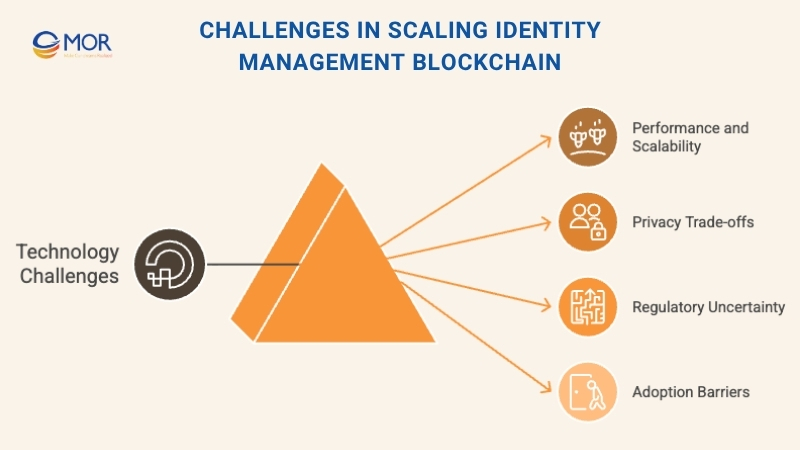
Performance And Scalability
As blockchain networks grow, so does the time required to process and validate transactions. In high-demand systems, this can create verification delays when thousands of users attempt identity checks simultaneously. This scalability issue remains one of the core aspects of the blockchain identity verification problem, where expanding network activity can slow confirmation times and affect user experience.
For blockchain identity verification to operate at enterprise scale, innovations like off-chain processing and layer-two protocols are being explored to reduce congestion and maintain speed. These improvements are essential for supporting widespread adoption across banking, healthcare, and government sectors.
Privacy Trade-Offs
Blockchain enhances data security, but privacy levels vary depending on the type of network used. Public blockchains make all transactions visible to participants, which can expose sensitive information if not carefully designed. Private or permissioned blockchains, on the other hand, restrict access to authorized users, maintaining confidentiality while preserving integrity. For regulated industries that handle personal data, identity in crypto systems built on permissioned networks strike the right balance between transparency and privacy protection.
Regulatory Uncertainty
Because identity management blockchain operates without a central authority, it doesn’t fit neatly within traditional regulatory systems. Laws governing blockchain use differ widely between countries, creating a fragmented compliance landscape. Some governments actively support blockchain innovation, while others impose restrictions due to data protection and jurisdictional concerns. For global organizations, adopting blockchain for identity verification requires navigating varying rules, making legal alignment both time-consuming and complex.
Adoption Barriers
Even with its clear advantages, blockchain identity management adoption remains gradual. Many enterprises hesitate to replace legacy systems with decentralized technology due to the high cost of integration and the absence of universal standards. A complete shift toward blockchain-based identity verification also requires collaboration across industries and regulators. Until there’s a consistent global framework and greater technical awareness, organizations may continue to rely on traditional identity systems despite their known limitations.
>>> READ MORE: What Is Blockchain Software Development? Guide, Tools, Best Tips
The Future Of Identity Management Blockchain
According to Market Research Future, the blockchain identity management market is projected to reach $17.81 billion by 2030, growing at a CAGR of 56.6% between 2022 and 2030. This rapid growth is driven by rising government initiatives and the global push to develop blockchain-based infrastructure across both developed and emerging economies.
Currently, North America leads in market share thanks to its advanced technology infrastructure and growing adoption of digital identity solutions. Businesses across finance, healthcare, and retail are investing heavily in blockchain digital identity systems to strengthen data protection and prevent fraud.
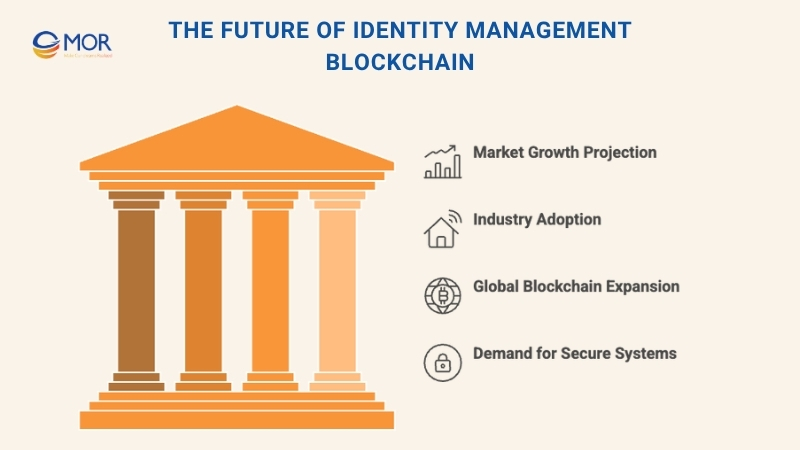
As industries accelerate digitization, the demand for secure, verifiable identity systems continues to grow. Identity management blockchain solutions offer a way to combat increasing cyberattacks and data breaches, giving individuals and organizations a trusted framework for secure online interactions and regulatory compliance.
Enterprise-Grade Identity Management Blockchain With MOR Software
MOR Software delivers enterprise-grade dapp development services designed to help organizations take control of digital identity with unmatched security, transparency, and scalability. Our approach combines technical expertise with business understanding to create real-world applications that move beyond theory.
We build decentralized identity systems that empower users to own and control their data while helping enterprises meet strict compliance standards like GDPR and CCPA. Every solution is tailored to industry-specific needs, ensuring privacy, traceability, and interoperability across complex digital ecosystems.
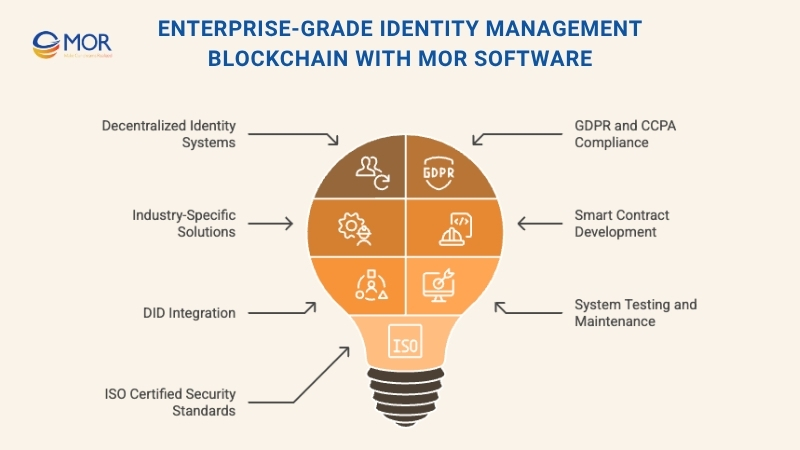
With certified engineers and experience across finance, healthcare, government, and supply chain, MOR Software develops web3 services that eliminate single points of failure and simplify verification processes. Our team handles everything from smart contract development and DID integration to system testing and long-term maintenance, guaranteeing stability at scale.
Backed by ISO 9001:2015 and ISO 27001:2013 certifications, we combine world-class security standards with deep technical capability. Whether you need a new identity platform or want to modernize existing systems, MOR Software JSC provides the expertise to make your blockchain identity management vision a reality.
Conclusion
As digital trust becomes a business priority, identity management blockchain offers the most secure and transparent path forward. It not only protects personal data but also builds lasting credibility between users and organizations. With MOR Software’s proven expertise in blockchain development and data security, your enterprise can move beyond traditional identity systems with confidence. Ready to build your future of secure digital identity? Contact us today.
MOR SOFTWARE
Frequently Asked Questions (FAQs)
What is identity management in blockchain?
Blockchain identity management refers to a decentralized method for creating, storing, and verifying digital identities. Instead of relying on a single authority, the blockchain allows individuals and organizations to manage their own credentials securely through encrypted, tamper-resistant records.
What is the blockchain for identification?
Blockchain enables identities to be verified almost instantly through transparent, traceable records. Individuals can manage their own profiles and decide what data to share, while trusted issuers can confirm credentials in seconds without intermediaries.
Which feature of blockchain technology is particularly beneficial for identity management?
Blockchain enhances identity security by removing central points of failure. Since user data is distributed across multiple nodes, hackers can’t easily alter or compromise it. This decentralized design makes identity records significantly harder to breach.
Can blockchain be used for authentication?
Yes. Blockchain authentication allows systems to verify users based on the same decentralized principles that power cryptocurrencies. It confirms identity through encrypted keys and records rather than passwords or centralized databases.
How does identity management work?
Identity management platforms help automate tasks like onboarding users, assigning access rights, and managing device permissions. Each user’s access is based on their verified role, ensuring smooth and secure control over who can use which systems.
What is the meaning of blockchain management?
Blockchain management refers to overseeing the network’s operations, including node maintenance, transaction validation, and data governance. It ensures the blockchain stays secure, synchronized, and compliant with the intended rules or protocols.
How to verify your identity on blockchain?
To verify your identity on a blockchain platform, log into your account and follow the on-screen instructions to submit your name, date of birth, and address. You may also be asked to upload ID documents and confirm your information to complete the verification.
What is digital identity management?
Digital identity management involves handling and protecting online user identities. It ensures each person or organization has a unique, verifiable digital profile that can be authenticated across platforms without risking data exposure.
Does blockchain reveal identity?
Not directly. Transactions are linked to public keys instead of personal details. However, if someone gathers enough transaction data over time, it’s possible to trace and connect public keys to real-world users.
How can blockchain technology best help securing identity data?
Blockchain uses cryptographic methods to record data permanently across multiple nodes. Once an identity record is added, it can’t be changed without broad network approval, which makes unauthorized alterations almost impossible.
How blockchain helps in digital identity?
Blockchain-based identity systems let people share only the information necessary for verification. For example, a person can prove they live in a certain city without revealing their full address, maintaining privacy while ensuring trust.
Why is blockchain often used in decentralized identity solutions?
Blockchain builds trust through a consensus model that verifies data across many independent nodes. Each block is cryptographically linked, so any attempt to alter data changes its hash and exposes tampering immediately.
How long does it take blockchain to verify identity?
The verification time depends on the platform and the clarity of the submitted documents. In most cases, once all information is correctly uploaded, the process can take anywhere from a few minutes to a couple of hours.
How can blockchain be used in identity management?
Blockchain supports secure, distributed storage of identity credentials. Because all entries are tamper-proof, it’s extremely difficult for anyone to alter or falsify identity data without detection.
What is a key as identity in blockchain?
In blockchain, identities rely on a pair of cryptographic keys. A public key serves as an address visible to others, while a private key is known only to the owner and is used to sign and verify transactions securely.
Rate this article
0
over 5.0 based on 0 reviews
Your rating on this news:
Name
*Email
*Write your comment
*Send your comment
1